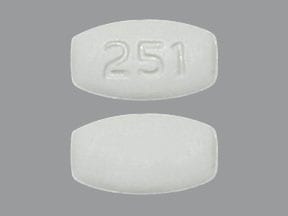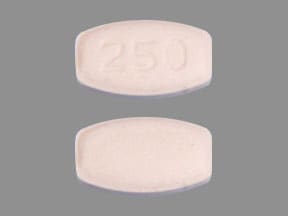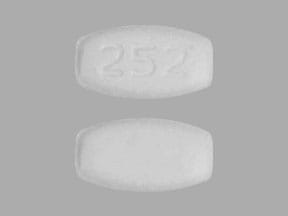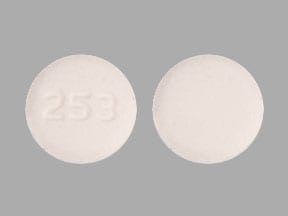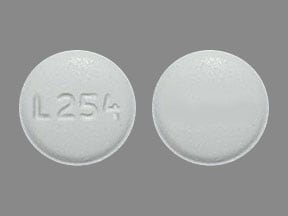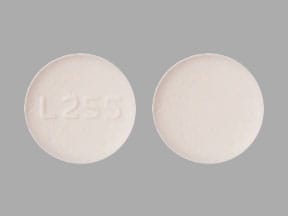Boxed Warning
Increased mortality in elderly patients with dementia-related psychosis:
Elderly patients with dementia-related psychosis treated with antipsychotic drugs are at an increased risk of death. Aripiprazole lauroxil is not approved for the treatment of patients with dementia-related psychosis.
Dosage Forms
Excipient information presented when available (limited, particularly for generics); consult specific product labeling.
Prefilled Syringe, Intramuscular:
Aristada: 1064 mg/3.9 mL (3.9 mL); 441 mg/1.6 mL (1.6 mL); 662 mg/2.4 mL (2.4 mL); 882 mg/3.2 mL (3.2 mL)
Prefilled Syringe, Intramuscular [preservative free]:
Aristada Initio: 675 mg/2.4 mL (2.4 mL)
Pharmacology
Mechanism of Action
Aripiprazole lauroxil is a prodrug of aripiprazole. Following intramuscular injection, aripiprazole lauroxil is likely converted by enzyme-mediated hydrolysis to N-hydroxymethyl aripiprazole, which is then hydrolyzed to aripiprazole. Aripiprazole is a quinolinone antipsychotic that exhibits high affinity for D2, D3, 5-HT1A, and 5-HT2A receptors; moderate affinity for D4, 5-HT2C, 5-HT7, alpha1 adrenergic, and H1 receptors. It also possesses moderate affinity for the serotonin reuptake transporter; has no affinity for muscarinic (cholinergic) receptors. Aripiprazole functions as a partial agonist at the D2 and 5-HT1A receptors, and as an antagonist at the 5-HT2A receptor (de Bartolomeis 2015).
Pharmacokinetics/Pharmacodynamics
Distribution
Vd: 268 L.
Metabolism
Prodrug; undergoes enzyme-mediated hydrolysis to N-hydroxymethyl aripiprazole followed by enzyme-mediated hydrolysis to aripiprazole. Aripiprazole undergoes hepatic metabolism via CYP2D6, CYP3A4 (dehydro-aripiprazole metabolite has affinity for D2 receptors similar to the parent drug and represents 40% of the parent drug exposure in plasma) (Sheehan 2010).
Onset of Action
Aristada: 5 to 6 days following injection; within 4 days following injection when administered concomitantly with oral aripiprazole.
Aristada Initio (675 mg strength nanocrystal dispersion): Reaches systemic circulation on day of injection; reaches clinically relevant serum concentrations 4 days following injection when administered concomitantly with oral aripiprazole 30 mg.
Time to Peak
Serum: Aristada Initio (675 mg strength nanocrystal dispersion): 16 to 35 days (median 27 days).
Duration of Action
Aristada: 36 days following appearance in the systemic circulation.
Half-Life Elimination
Aristada: 53.9 to 57.2 days.
Aristada Initio (675 mg strength nanocrystal dispersion): 15 to 18 days.
Protein Binding
>99%, primarily to albumin.
Use: Labeled Indications
Schizophrenia: Treatment of schizophrenia in adults.
Limitations of use: The 675 mg strength aripiprazole lauroxil nanocrystal dispersion (Aristada Initio) is only to be used as a single dose in combination with oral aripiprazole for initiation of long-term treatment with aripiprazole lauroxil (Aristada) or as a single dose to reinitiate treatment after a missed dose of aripiprazole lauroxil (Aristada). It is not intended for repeat dosing.
Contraindications
Hypersensitivity (eg, anaphylaxis, pruritus, urticaria) to aripiprazole or any component of the formulation.
Dosage and Administration
Dosing: Adult
Note: Formulations: Aripiprazole lauroxil is a prodrug of aripiprazole formulated as an ER suspension for IM injection. Another ER suspension for IM injection is available as aripiprazole monohydrate (see Aripiprazole monograph). All doses, for all routes of administration, are expressed as the equivalent amounts of aripiprazole base in both monographs. When initiating aripiprazole lauroxil or restarting after missed doses, a 675 mg nanocrystal dispersion preparation of aripiprazole lauroxil (Aristada Initio) is an option for one-time use. The 675 mg nanocrystal dispersion (Aristada Initio) is not to be used for repeated dosing due to pharmacokinetic differences with other aripiprazole lauroxil strengths.
Schizophrenia: IM: Note: Establish tolerability with oral aripiprazole prior to initiating treatment. Avoid use of 675 mg nanocrystal dispersion (Aristada Initio) in known CYP2D6 poor metabolizers.
Initial dose options:
1-day oral overlap using Aristada Initio: Administer a single oral aripiprazole 30 mg dose, a single 675 mg dose of nanocrystal dispersion (Aristada Initio), plus the first dose of aripiprazole lauroxil based on current oral aripiprazole dose (see conversion below) with or within 10 days after administering the 675 mg dose.
or
21-day oral overlap: Administer oral aripiprazole for 21 days in conjunction with first dose of aripiprazole lauroxil based on the current oral aripiprazole dose (see conversion below).
Conversion of oral aripiprazole to IM aripiprazole lauroxil (Aristada):
Oral aripiprazole 10 mg/day: Initial IM aripiprazole lauroxil (Aristada) dose: 441 mg per month.
Oral aripiprazole 15 mg/day: Initial IM aripiprazole lauroxil (Aristada) dose: 662 mg per month or 882 mg every 6 weeks or 1,064 mg every 2 months.
Oral aripiprazole ≥20 mg/day: Initial IM aripiprazole lauroxil (Aristada) dose: 882 mg every month.
Dosage adjustment: Adjust aripiprazole lauroxil dose as needed; if a dose is required earlier than the recommended interval(s), do not administer <14 days after the previous injection.
Missed dose: Administer missed dose as soon as possible. Supplemental dose(s) may be appropriate; see table below. In patients who require oral supplemental dose(s), administer the same dose of oral aripiprazole that the patient was receiving prior to initiation of aripiprazole lauroxil, unless otherwise indicated.
|
Supplemental Dose Recommendations Following Missed Doses |
|||
|---|---|---|---|
|
Dose of Last Aripiprazole Lauroxil (Aristada) Injection |
Length of Time Since Last Injection |
||
|
441 mg |
≤6 weeks |
>6 and ≤7 weeks |
>7 weeks |
|
662 mg |
≤8 weeks |
>8 and ≤12 weeks |
>12 weeks |
|
882 mg |
≤8 weeks |
>8 and ≤12 weeks |
>12 weeks |
|
1,064 mg |
≤10 weeks |
>10 and ≤12 weeks |
>12 weeks |
|
Dosage and Administration for Re-initiation of Aripiprazole Lauroxil (Aristada) Injection |
No supplementation required |
Supplement with: 1) Oral aripiprazole for 7 days or 2) Single dose of aripiprazole lauroxil nanocrystal dispersion (Aristada Initio) 675 mg |
Supplement with: 1) Oral aripiprazole for 21 days or 2) Single dose of aripiprazole lauroxil nanocrystal dispersion (Aristada Initio) 675 mg and a single dose of oral aripiprazole 30 mg |
Table was converted to the following text:
Supplemental Dose Recommendations Following Missed Doses
Current dose of aripiprazole lauroxil (Aristada): 441 mg
Last injection occurred ≤6 weeks ago: Administer aripiprazole lauroxil (Aristada) immediately; no aripiprazole supplementation required.
Last injection occurred >6 and ≤7 weeks ago: Administer aripiprazole lauroxil (Aristada) immediately in conjunction with:
Oral aripiprazole supplementation for 7 days
or
Single dose of aripiprazole lauroxil nanocrystal dispersion (Aristada Initio) 675 mg
Last injection occurred >7 weeks ago: Administer aripiprazole lauroxil (Aristada) immediately in conjunction with:
Oral aripiprazole supplementation for 21 days
or
Single dose of aripiprazole lauroxil nanocrystal dispersion (Aristada Initio) 675 mg and a single dose of oral aripiprazole 30 mg
Current dose of aripiprazole lauroxil (Aristada): 662 mg or 882 mg
Last injection occurred ≤8 weeks ago: Administer aripiprazole lauroxil (Aristada) immediately; no aripiprazole supplementation required
Last injection occurred >8 and ≤12 weeks ago: Administer aripiprazole lauroxil (Aristada) immediately in conjunction with:
Oral aripiprazole supplementation for 7 days
i
Single dose of aripiprazole lauroxil nanocrystal dispersion (Aristada Initio) 675 mg
Last injection occurred >12 weeks ago: Administer aripiprazole lauroxil (Aristada) immediately in conjunction with:
Oral aripiprazole supplementation for 21 days
or
Single dose of aripiprazole lauroxil nanocrystal dispersion (Aristada Initio) 675 mg and a single dose of oral aripiprazole 30 mg
Current dose of aripiprazole lauroxil (Aristada): 1,064 mg
Last injection occurred ≤10 weeks ago: Administer aripiprazole lauroxil (Aristada) immediately; no aripiprazole supplementation required
Last injection occurred >10 and ≤12 weeks ago: Administer aripiprazole lauroxil (Aristada) immediately in conjunction with:
Oral aripiprazole supplementation for 7 days
or
Single dose of aripiprazole lauroxil nanocrystal dispersion (Aristada Initio) 675 mg
Last injection occurred >12 weeks ago: Administer aripiprazole lauroxil (Aristada) immediately in conjunction with:
Oral aripiprazole supplementation for 21 days
or
Single dose of aripiprazole lauroxil nanocrystal dispersion (Aristada Initio) 675 mg and a single dose of oral aripiprazole 30 mg
Discontinuation of therapy: Gradual dose reduction is advised to avoid withdrawal symptoms (ie, insomnia, headache, GI symptoms) unless discontinuation is due to significant adverse effects. Generally, when discontinuing antipsychotic therapy for a chronic psychiatric disorder (eg, schizophrenia), decreasing the dose gradually over months with close monitoring may be appropriate and may enable clinicians to detect prodromal symptoms of disease recurrence (APA [Lehman 2004]; CPA 2005).
Switching antipsychotics: An optimal, universal strategy for switching antipsychotic drugs has not been established. Strategies include: Cross-titration (gradually discontinuing the first antipsychotic while gradually increasing the new antipsychotic) and abrupt change (abruptly discontinuing the first antipsychotic and either increasing the new antipsychotic gradually or starting it at a treatment dose). In patients with schizophrenia at high risk of relapse, the current medication may be maintained at full dose as the new medication is increased (ie, overlap); once the new medication is at therapeutic dose, the first medication is gradually decreased and discontinued over 1 to 2 weeks (Cerovecki 2013; Remington 2005; Takeuchi 2017). Based upon clinical experience, some experts generally prefer cross-titration and overlap approaches rather than abrupt change (Post 2019; Stroup 2019).
Administration
IM: For IM administration only. Administer the 441 mg dose (Aristada) and the 675 mg nanocrystal dispersion dose (Aristada Initio) in the deltoid or gluteal muscle, and other dose strengths (Aristada) in the gluteal muscle. Inject in a rapid and continuous manner. Avoid administering aripiprazole lauroxil nanocrystal dispersion (Aristada Initio) and aripiprazole lauroxil (Aristada) concurrently in the same muscle. Prior to administration, tap the syringe at least 10 times and then shake the syringe vigorously ≥30 seconds to ensure a uniform suspension. If the syringe is not used within 15 minutes, shake again for 30 seconds. Use the appropriate sized needle for the injection site; a 21-gauge, 1 inch or 20-gauge, 1.5-inch needle for deltoid injection and a 20-gauge, 1.5- or 2-inch needle for gluteal injection. Use the longer needles for patients with a larger amount of subcutaneous tissue overlaying the injection site muscle.
Storage
Store at 20°C to 25°C (68°F to 77°F); excursions permitted between 15°C and 30°C (59°F and 86°F).
ARIPiprazole Lauroxil Images
Drug Interactions
Abiraterone Acetate: May increase the serum concentration of CYP2D6 Substrates (High risk with Inhibitors). Management: Avoid concurrent use of abiraterone with CYP2D6 substrates that have a narrow therapeutic index whenever possible. When concurrent use is not avoidable, monitor patients closely for signs/symptoms of toxicity. Consider therapy modification
Acetylcholinesterase Inhibitors (Central): May enhance the neurotoxic (central) effect of Antipsychotic Agents. Severe extrapyramidal symptoms have occurred in some patients. Monitor therapy
Ajmaline: May increase the serum concentration of CYP2D6 Substrates (High risk with Inhibitors). Monitor therapy
Alcohol (Ethyl): CNS Depressants may enhance the CNS depressant effect of Alcohol (Ethyl). Monitor therapy
Alizapride: May enhance the CNS depressant effect of CNS Depressants. Monitor therapy
Amifampridine: Agents With Seizure Threshold Lowering Potential may enhance the neuroexcitatory and/or seizure-potentiating effect of Amifampridine. Monitor therapy
Amisulpride: Antipsychotic Agents may enhance the adverse/toxic effect of Amisulpride. Management: Drugs listed as exceptions to this monograph are discussed in further detail in separate drug interaction monographs. Avoid combination
Amphetamines: Antipsychotic Agents may diminish the stimulatory effect of Amphetamines. Monitor therapy
Antidiabetic Agents: Hyperglycemia-Associated Agents may diminish the therapeutic effect of Antidiabetic Agents. Monitor therapy
Anti-Parkinson Agents (Dopamine Agonist): Antipsychotic Agents (Second Generation [Atypical]) may diminish the therapeutic effect of Anti-Parkinson Agents (Dopamine Agonist). Management: Consider using an alternative antipsychotic agent when possible in patients with Parkinson disease. If an atypical antipsychotic is necessary, consider using clozapine or quetiapine, which may convey the lowest interaction risk. Consider therapy modification
Aprepitant: May increase the serum concentration of CYP3A4 Substrates (High risk with Inhibitors). Monitor therapy
Asunaprevir: May increase the serum concentration of CYP2D6 Substrates (High risk with Inhibitors). Consider therapy modification
Azelastine (Nasal): CNS Depressants may enhance the CNS depressant effect of Azelastine (Nasal). Avoid combination
Blonanserin: CNS Depressants may enhance the CNS depressant effect of Blonanserin. Consider therapy modification
Blood Pressure Lowering Agents: May enhance the hypotensive effect of Antipsychotic Agents (Second Generation [Atypical]). Monitor therapy
Bosentan: May decrease the serum concentration of CYP3A4 Substrates (High risk with Inducers). Monitor therapy
Brexanolone: CNS Depressants may enhance the CNS depressant effect of Brexanolone. Monitor therapy
Brimonidine (Topical): May enhance the CNS depressant effect of CNS Depressants. Monitor therapy
Bromopride: May enhance the adverse/toxic effect of Antipsychotic Agents. Avoid combination
Bromperidol: May enhance the CNS depressant effect of CNS Depressants. Avoid combination
Buprenorphine: CNS Depressants may enhance the CNS depressant effect of Buprenorphine. Management: Consider reduced doses of other CNS depressants, and avoiding such drugs in patients at high risk of buprenorphine overuse/self-injection. Initiate buprenorphine at lower doses in patients already receiving CNS depressants. Consider therapy modification
Cannabidiol: May enhance the CNS depressant effect of CNS Depressants. Monitor therapy
Cannabis: May enhance the CNS depressant effect of CNS Depressants. Monitor therapy
Chlormethiazole: May enhance the CNS depressant effect of CNS Depressants. Management: Monitor closely for evidence of excessive CNS depression. The chlormethiazole labeling states that an appropriately reduced dose should be used if such a combination must be used. Consider therapy modification
Chlorphenesin Carbamate: May enhance the adverse/toxic effect of CNS Depressants. Monitor therapy
CloBAZam: May increase the serum concentration of CYP2D6 Substrates (High risk with Inhibitors). Monitor therapy
Clofazimine: May increase the serum concentration of CYP3A4 Substrates (High risk with Inhibitors). Monitor therapy
CNS Depressants: May enhance the adverse/toxic effect of other CNS Depressants. Monitor therapy
Conivaptan: May increase the serum concentration of CYP3A4 Substrates (High risk with Inhibitors). Avoid combination
CYP2D6 Inhibitors (Moderate): May decrease the metabolism of CYP2D6 Substrates (High risk with Inhibitors). Monitor therapy
CYP2D6 Inhibitors (Strong): May increase serum concentrations of the active metabolite(s) of ARIPiprazole Lauroxil. Management: Please refer to the full interaction monograph for details concerning the recommended dose adjustments. Consider therapy modification
CYP3A4 Inducers (Moderate): May decrease the serum concentration of CYP3A4 Substrates (High risk with Inducers). Monitor therapy
CYP3A4 Inducers (Strong): May decrease serum concentrations of the active metabolite(s) of ARIPiprazole Lauroxil. Management: Patients taking the 441 mg dose of aripiprazole lauroxil increase their dose to 662 mg if used with a strong CYP3A4 inducer for more than 14 days. No dose adjustment is necessary for patients using the higher doses of aripiprazole lauroxil. Consider therapy modification
CYP3A4 Inhibitors (Moderate): May decrease the metabolism of CYP3A4 Substrates (High risk with Inhibitors). Monitor therapy
CYP3A4 Inhibitors (Strong): May increase serum concentrations of the active metabolite(s) of ARIPiprazole Lauroxil. Management: Please refer to the full interaction monograph for details concerning the recommended dose adjustments. Consider therapy modification
Dabrafenib: May decrease the serum concentration of CYP3A4 Substrates (High risk with Inducers). Management: Seek alternatives to the CYP3A4 substrate when possible. If concomitant therapy cannot be avoided, monitor clinical effects of the substrate closely (particularly therapeutic effects). Consider therapy modification
Dacomitinib: May increase the serum concentration of CYP2D6 Substrates (High risk with Inhibitors). Management: Avoid concurrent use of dacomitinib with CYP2D6 subtrates that have a narrow therapeutic index. Consider therapy modification
Deferasirox: May decrease the serum concentration of CYP3A4 Substrates (High risk with Inducers). Monitor therapy
Deutetrabenazine: May enhance the adverse/toxic effect of Antipsychotic Agents. Specifically, the risk for akathisia, parkinsonism, or neuroleptic malignant syndrome may be increased. Monitor therapy
Dimethindene (Topical): May enhance the CNS depressant effect of CNS Depressants. Monitor therapy
Doxylamine: May enhance the CNS depressant effect of CNS Depressants. Management: The manufacturer of Diclegis (doxylamine/pyridoxine), intended for use in pregnancy, specifically states that use with other CNS depressants is not recommended. Monitor therapy
Dronabinol: May enhance the CNS depressant effect of CNS Depressants. Monitor therapy
Droperidol: May enhance the CNS depressant effect of CNS Depressants. Management: Consider dose reductions of droperidol or of other CNS agents (eg, opioids, barbiturates) with concomitant use. Exceptions to this monograph are discussed in further detail in separate drug interaction monographs. Consider therapy modification
Duvelisib: May increase the serum concentration of CYP3A4 Substrates (High risk with Inhibitors). Monitor therapy
Enzalutamide: May decrease the serum concentration of CYP3A4 Substrates (High risk with Inducers). Management: Concurrent use of enzalutamide with CYP3A4 substrates that have a narrow therapeutic index should be avoided. Use of enzalutamide and any other CYP3A4 substrate should be performed with caution and close monitoring. Consider therapy modification
Erdafitinib: May decrease the serum concentration of CYP3A4 Substrates (High risk with Inducers). Monitor therapy
Erdafitinib: May increase the serum concentration of CYP3A4 Substrates (High risk with Inhibitors). Monitor therapy
Esketamine: May enhance the CNS depressant effect of CNS Depressants. Monitor therapy
Flunitrazepam: CNS Depressants may enhance the CNS depressant effect of Flunitrazepam. Consider therapy modification
Fosaprepitant: May increase the serum concentration of CYP3A4 Substrates (High risk with Inhibitors). Monitor therapy
Fosnetupitant: May increase the serum concentration of CYP3A4 Substrates (High risk with Inhibitors). Monitor therapy
Fusidic Acid (Systemic): May increase the serum concentration of CYP3A4 Substrates (High risk with Inhibitors). Avoid combination
Guanethidine: Antipsychotic Agents may diminish the therapeutic effect of Guanethidine. Monitor therapy
HYDROcodone: CNS Depressants may enhance the CNS depressant effect of HYDROcodone. Management: Avoid concomitant use of hydrocodone and benzodiazepines or other CNS depressants when possible. These agents should only be combined if alternative treatment options are inadequate. If combined, limit the dosages and duration of each drug. Consider therapy modification
HydrOXYzine: May enhance the CNS depressant effect of CNS Depressants. Monitor therapy
Idelalisib: May increase the serum concentration of CYP3A4 Substrates (High risk with Inhibitors). Avoid combination
Imatinib: May increase the serum concentration of CYP2D6 Substrates (High risk with Inhibitors). Monitor therapy
Iohexol: Agents With Seizure Threshold Lowering Potential may enhance the adverse/toxic effect of Iohexol. Specifically, the risk for seizures may be increased. Management: Discontinue agents that may lower the seizure threshold 48 hours prior to intrathecal use of iohexol. Wait at least 24 hours after the procedure to resume such agents. In nonelective procedures, consider use of prophylactic anticonvulsants. Consider therapy modification
Iomeprol: Agents With Seizure Threshold Lowering Potential may enhance the adverse/toxic effect of Iomeprol. Specifically, the risk for seizures may be increased. Management: Discontinue agents that may lower the seizure threshold 48 hours prior to intrathecal use of iomeprol. Wait at least 24 hours after the procedure to resume such agents. In nonelective procedures, consider use of prophylactic anticonvulsants. Consider therapy modification
Iopamidol: Agents With Seizure Threshold Lowering Potential may enhance the adverse/toxic effect of Iopamidol. Specifically, the risk for seizures may be increased. Management: Discontinue agents that may lower the seizure threshold 48 hours prior to intrathecal use of iopamidol. Wait at least 24 hours after the procedure to resume such agents. In nonelective procedures, consider use of prophylactic anticonvulsants. Consider therapy modification
Ivosidenib: May decrease the serum concentration of CYP3A4 Substrates (High risk with Inducers). Monitor therapy
Kava Kava: May enhance the adverse/toxic effect of CNS Depressants. Monitor therapy
Larotrectinib: May increase the serum concentration of CYP3A4 Substrates (High risk with Inhibitors). Monitor therapy
Lemborexant: May enhance the CNS depressant effect of CNS Depressants. Management: Dosage adjustments of lemborexant and of concomitant CNS depressants may be necessary when administered together because of potentially additive CNS depressant effects. Close monitoring for CNS depressant effects is necessary. Consider therapy modification
Lithium: May enhance the neurotoxic effect of Antipsychotic Agents. Lithium may decrease the serum concentration of Antipsychotic Agents. Specifically noted with chlorpromazine. Monitor therapy
Lofexidine: May enhance the CNS depressant effect of CNS Depressants. Management: Drugs listed as exceptions to this monograph are discussed in further detail in separate drug interaction monographs. Monitor therapy
Lorlatinib: May decrease the serum concentration of CYP3A4 Substrates (High risk with Inducers). Management: Avoid concurrent use of lorlatinib with any CYP3A4 substrates for which a minimal decrease in serum concentrations of the CYP3A4 substrate could lead to therapeutic failure and serious clinical consequences. Consider therapy modification
Lumefantrine: May increase the serum concentration of CYP2D6 Substrates (High risk with Inhibitors). Monitor therapy
Magnesium Sulfate: May enhance the CNS depressant effect of CNS Depressants. Monitor therapy
Mequitazine: Antipsychotic Agents may enhance the arrhythmogenic effect of Mequitazine. Management: Consider alternatives to one of these agents when possible. While this combination is not specifically contraindicated, mequitazine labeling describes this combination as discouraged. Consider therapy modification
Methotrimeprazine: CNS Depressants may enhance the CNS depressant effect of Methotrimeprazine. Methotrimeprazine may enhance the CNS depressant effect of CNS Depressants. Management: Reduce adult dose of CNS depressant agents by 50% with initiation of concomitant methotrimeprazine therapy. Further CNS depressant dosage adjustments should be initiated only after clinically effective methotrimeprazine dose is established. Consider therapy modification
Methylphenidate: Antipsychotic Agents may enhance the adverse/toxic effect of Methylphenidate. Methylphenidate may enhance the adverse/toxic effect of Antipsychotic Agents. Monitor therapy
Metoclopramide: May enhance the adverse/toxic effect of Antipsychotic Agents. Avoid combination
MetyroSINE: CNS Depressants may enhance the sedative effect of MetyroSINE. Monitor therapy
MetyroSINE: May enhance the adverse/toxic effect of Antipsychotic Agents. Monitor therapy
MiFEPRIStone: May increase the serum concentration of CYP3A4 Substrates (High risk with Inhibitors). Management: Minimize doses of CYP3A4 substrates, and monitor for increased concentrations/toxicity, during and 2 weeks following treatment with mifepristone. Avoid cyclosporine, dihydroergotamine, ergotamine, fentanyl, pimozide, quinidine, sirolimus, and tacrolimus. Consider therapy modification
Minocycline (Systemic): May enhance the CNS depressant effect of CNS Depressants. Monitor therapy
Mitotane: May decrease the serum concentration of CYP3A4 Substrates (High risk with Inducers). Management: Doses of CYP3A4 substrates may need to be adjusted substantially when used in patients being treated with mitotane. Consider therapy modification
Nabilone: May enhance the CNS depressant effect of CNS Depressants. Monitor therapy
Netupitant: May increase the serum concentration of CYP3A4 Substrates (High risk with Inhibitors). Monitor therapy
Opioid Agonists: CNS Depressants may enhance the CNS depressant effect of Opioid Agonists. Management: Avoid concomitant use of opioid agonists and benzodiazepines or other CNS depressants when possible. These agents should only be combined if alternative treatment options are inadequate. If combined, limit the dosages and duration of each drug. Consider therapy modification
Orphenadrine: CNS Depressants may enhance the CNS depressant effect of Orphenadrine. Avoid combination
Oxomemazine: May enhance the CNS depressant effect of CNS Depressants. Avoid combination
OxyCODONE: CNS Depressants may enhance the CNS depressant effect of OxyCODONE. Management: Avoid concomitant use of oxycodone and benzodiazepines or other CNS depressants when possible. These agents should only be combined if alternative treatment options are inadequate. If combined, limit the dosages and duration of each drug. Consider therapy modification
Palbociclib: May increase the serum concentration of CYP3A4 Substrates (High risk with Inhibitors). Monitor therapy
Panobinostat: May increase the serum concentration of CYP2D6 Substrates (High risk with Inhibitors). Monitor therapy
Paraldehyde: CNS Depressants may enhance the CNS depressant effect of Paraldehyde. Avoid combination
Peginterferon Alfa-2b: May decrease the serum concentration of CYP2D6 Substrates (High risk with Inhibitors). Peginterferon Alfa-2b may increase the serum concentration of CYP2D6 Substrates (High risk with Inhibitors). Monitor therapy
Perampanel: May enhance the CNS depressant effect of CNS Depressants. Management: Patients taking perampanel with any other drug that has CNS depressant activities should avoid complex and high-risk activities, particularly those such as driving that require alertness and coordination, until they have experience using the combination. Consider therapy modification
Perhexiline: CYP2D6 Substrates (High risk with Inhibitors) may increase the serum concentration of Perhexiline. Perhexiline may increase the serum concentration of CYP2D6 Substrates (High risk with Inhibitors). Monitor therapy
Piribedil: Antipsychotic Agents may diminish the therapeutic effect of Piribedil. Piribedil may diminish the therapeutic effect of Antipsychotic Agents. Management: Use of piribedil with antiemetic neuroleptics is contraindicated, and use with antipsychotic neuroleptics, except for clozapine, is not recommended. Avoid combination
Quinagolide: Antipsychotic Agents may diminish the therapeutic effect of Quinagolide. Monitor therapy
QuiNINE: May increase the serum concentration of CYP2D6 Substrates (High risk with Inhibitors). Monitor therapy
Rufinamide: May enhance the adverse/toxic effect of CNS Depressants. Specifically, sleepiness and dizziness may be enhanced. Monitor therapy
Sarilumab: May decrease the serum concentration of CYP3A4 Substrates (High risk with Inducers). Monitor therapy
Selective Serotonin Reuptake Inhibitors: CNS Depressants may enhance the adverse/toxic effect of Selective Serotonin Reuptake Inhibitors. Specifically, the risk of psychomotor impairment may be enhanced. Monitor therapy
Serotonergic Agents (High Risk): May enhance the adverse/toxic effect of Antipsychotic Agents. Specifically, serotonergic agents may enhance dopamine blockade, possibly increasing the risk for neuroleptic malignant syndrome. Antipsychotic Agents may enhance the serotonergic effect of Serotonergic Agents (High Risk). This could result in serotonin syndrome. Monitor therapy
Siltuximab: May decrease the serum concentration of CYP3A4 Substrates (High risk with Inducers). Monitor therapy
Simeprevir: May increase the serum concentration of CYP3A4 Substrates (High risk with Inhibitors). Monitor therapy
Sodium Oxybate: May enhance the CNS depressant effect of CNS Depressants. Management: Consider alternatives to combined use. When combined use is needed, consider minimizing doses of one or more drugs. Use of sodium oxybate with alcohol or sedative hypnotics is contraindicated. Consider therapy modification
Stiripentol: May increase the serum concentration of CYP3A4 Substrates (High risk with Inhibitors). Management: Use of stiripentol with CYP3A4 substrates that are considered to have a narrow therapeutic index should be avoided due to the increased risk for adverse effects and toxicity. Any CYP3A4 substrate used with stiripentol requires closer monitoring. Consider therapy modification
Sulpiride: Antipsychotic Agents may enhance the adverse/toxic effect of Sulpiride. Avoid combination
Suvorexant: CNS Depressants may enhance the CNS depressant effect of Suvorexant. Management: Dose reduction of suvorexant and/or any other CNS depressant may be necessary. Use of suvorexant with alcohol is not recommended, and the use of suvorexant with any other drug to treat insomnia is not recommended. Consider therapy modification
Tapentadol: May enhance the CNS depressant effect of CNS Depressants. Management: Avoid concomitant use of tapentadol and benzodiazepines or other CNS depressants when possible. These agents should only be combined if alternative treatment options are inadequate. If combined, limit the dosages and duration of each drug. Consider therapy modification
Tetrabenazine: May enhance the adverse/toxic effect of Antipsychotic Agents. Monitor therapy
Tetrahydrocannabinol: May enhance the CNS depressant effect of CNS Depressants. Monitor therapy
Tetrahydrocannabinol and Cannabidiol: May enhance the CNS depressant effect of CNS Depressants. Monitor therapy
Thalidomide: CNS Depressants may enhance the CNS depressant effect of Thalidomide. Avoid combination
Tocilizumab: May decrease the serum concentration of CYP3A4 Substrates (High risk with Inducers). Monitor therapy
Trimeprazine: May enhance the CNS depressant effect of CNS Depressants. Monitor therapy
Zolpidem: CNS Depressants may enhance the CNS depressant effect of Zolpidem. Management: Reduce the Intermezzo brand sublingual zolpidem adult dose to 1.75 mg for men who are also receiving other CNS depressants. No such dose change is recommended for women. Avoid use with other CNS depressants at bedtime; avoid use with alcohol. Consider therapy modification
Adverse Reactions
>10%: Central nervous system: Akathisia (11%)
1% to 10%:
Central nervous system: Headache (5%), parkinsonian-like syndrome (4%), insomnia (3% to 4%), restlessness (3%), dystonia (2%)
Endocrine & metabolic: Weight gain (2%; ≥7% increase: 9% to 10%)
Local: Pain at injection site (3% to 4%)
Neuromuscular & skeletal: Increased creatine phosphokinase (1% to 2%)
Frequency not defined:
Cardiovascular: Angina pectoris, palpitations, tachycardia
Central nervous system: Anxiety, dizziness, myasthenia
Gastrointestinal: Constipation, xerostomia
Neuromuscular & skeletal: Asthenia
<1%, postmarketing, and/or case reports: Erythema at injection site, impulse control disorder (including compulsive shopping, intense gambling urges, binge eating, and hypersexuality), induration at injection site, orthostatic hypotension (patient taking 882 mg aripiprazole lauroxil), swelling at injection site
Warnings/Precautions
Concerns related to adverse effects:
- Altered cardiac conduction: May alter cardiac conduction; life-threatening arrhythmias have occurred with therapeutic doses of antipsychotics.
- Blood dyscrasias: Leukopenia, neutropenia, and agranulocytosis (sometimes fatal) have been reported in clinical trials and postmarketing reports with antipsychotic use; presence of risk factors (eg, preexisting low WBC/ANC or history of drug-induced leuko-/neutropenia) should prompt periodic blood count assessment. Discontinue therapy at first signs of blood dyscrasias or if absolute neutrophil count <1,000/mm3.
- Cerebrovascular effects: An increased incidence of cerebrovascular effects (eg, transient ischemic attack, stroke), including fatalities, has been reported in placebo-controlled trials of antipsychotics for the unapproved use in elderly patients with dementia-related psychosis.
- CNS depression: May cause CNS depression, which may impair physical or mental abilities; patients must be cautioned about performing tasks that require mental alertness (eg, operating machinery, driving).
- Dyslipidemia: Lipid changes, including increases in total cholesterol, LDL cholesterol, and triglycerides and decreases in HDL cholesterol, have been reported; risk profile may differ between antipsychotic agents. Compared to other antipsychotics, the risk of dyslipidemia with aripiprazole lauroxil is minimal-to-low (Solmi 2017).
- Esophageal dysmotility/aspiration: Antipsychotic use has been associated with esophageal dysmotility and aspiration; risk increases with age. Use with caution in patients at risk for aspiration pneumonia (eg, Alzheimer disease), particularly in patients >75 years (Herzig 2017; Maddalena 2004).
- Extrapyramidal symptoms: May cause extrapyramidal symptoms (EPS), including pseudoparkinsonism, acute dystonic reactions, akathisia, and tardive dyskinesia (risk of these reactions is generally much lower relative to typical/conventional antipsychotics; frequencies reported are similar to placebo). Risk of dystonia (and probably other EPS) may be greater with increased doses, use of conventional antipsychotics, males, and younger patients. Factors associated with greater vulnerability to tardive dyskinesia include older in age, female gender combined with postmenopausal status, Parkinson disease, pseudoparkinsonism symptoms, affective disorders (particularly major depressive disorder), concurrent medical diseases such as diabetes, previous brain damage, alcoholism, poor treatment response, and use of high doses of antipsychotics (APA [Lehman 2004]; Soares-Weiser 2007). Consider therapy discontinuation with signs/symptoms of tardive dyskinesia.
- Falls: May increase the risk for falls due to somnolence, orthostatic hypotension, and motor or sensory instability. Complete fall risk assessments at baseline and periodically during treatment in patients with diseases or on medications that may also increase fall risk.
- Hyperglycemia: Atypical antipsychotics have been associated with development of hyperglycemia; in some cases, may be extreme and associated with ketoacidosis, hyperosmolar coma, or death. All patients should be monitored for symptoms of hyperglycemia (eg, polydipsia, polyuria, polyphagia, weakness). Use with caution in patients with diabetes or other disorders of glucose regulation; monitor for worsening of glucose control. Patients with risk factors for diabetes (eg, obesity or family history) should have a baseline fasting blood sugar and periodic assessment of glucose regulation. Hyperglycemia may resolve with discontinuation of therapy; however, some patients may require treatment of diabetes after discontinuation of therapy. Compared to other antipsychotics, the risk of hyperglycemia with aripiprazole lauroxil is minimal-to-low (Solmi 2017).
- Impulse control disorders: Has been associated with compulsive behaviors and/or loss of impulse control, which has manifested as pathological gambling, uncontrolled sexual urges, uncontrolled spending, binge or compulsive eating, and/or other intense urges. Patients with prior history of impulse control issues may be at increased risk. Dose reduction or discontinuation of therapy has been reported to reverse these behaviors in most, but not all, cases (Gaboriau 2014; Moore 2014; Smith 2011).
- Neuroleptic malignant syndrome: Use may be associated with neuroleptic malignant syndrome; monitor for mental status changes, fever, muscle rigidity and/or autonomic instability.
- Orthostatic hypotension: May cause orthostatic hypotension; increased risk at initiation of therapy or during dose escalation. Use with caution in patients at risk of this effect or in those who would not tolerate transient hypotensive episodes (cerebrovascular disease, cardiovascular disease, hypovolemia, or concurrent medication use which may predispose to hypotension/bradycardia). Consider using lower starting dosages and slower titrations in these patients.
- Temperature regulation: Impaired core body temperature regulation may occur; caution with strenuous exercise, heat exposure, dehydration, and concomitant medication possessing anticholinergic effects.
- Weight gain: Significant weight gain has been observed with antipsychotic therapy; incidence varies with product. Monitoring of weight is recommended. Compared to other antipsychotics, the risk of weight gain with aripiprazole lauroxil is minimal (Solmi 2017).
Disease-related concerns:
- Cardiovascular disease: Use with caution in patients with cardiac disease, cerebrovascular disease, prior myocardial infarction, ischemic heart disease, or conditions which predispose to hypotension.
- Dementia: [US Boxed Warning]: Elderly patients with dementia-related psychosis treated with antipsychotics are at an increased risk of death compared to placebo. Most deaths appeared to be either cardiovascular (eg, heart failure, sudden death) or infectious (eg, pneumonia) in nature. Use with caution in patients with Lewy body dementia or Parkinson disease dementia due to greater risk of adverse effects, increased sensitivity to extrapyramidal effects, and association with irreversible cognitive decompensation or death (APA [Reus 2016]). Aripiprazole lauroxil is not approved for the treatment of dementia-related psychosis.
- Parkinson disease: Use with caution in patients with Parkinson disease; antipsychotics may aggravate motor disturbances (APA [Lehman 2004; Reus 2016]).
- Seizures: Use with caution in patients at risk of seizures, including those with a history of seizures, head trauma, brain damage, alcoholism, or concurrent therapy with medications which may lower seizure threshold. Elderly patients may be at increased risk of seizures due to an increased prevalence of predisposing factors.
Concurrent drug therapy issues:
- Drug-drug interactions: Potentially significant interactions may exist, requiring dose or frequency adjustment, additional monitoring, and/or selection of alternative therapy. Consult drug interactions database for more detailed information.
Special populations:
- CYP2D6 poor metabolizers: Known CYP2D6 poor metabolizers may be at risk for elevated aripiprazole concentrations. Avoid use of the 675 mg strength aripiprazole lauroxil nanocrystal dispersion (Aristada Initio) in this population; dose adjustment is required with other strengths of aripiprazole lauroxil (Aristada).
Other warnings/precautions:
- Appropriate use: Medication errors, including substitution and dispensing errors, could occur between the 675 mg strength aripiprazole lauroxil nanocrystal dispersion (Aristada Initio) and other aripiprazole lauroxil strengths (Aristada). The 675 mg strength nanocrystal dispersion (Aristada Initio) is not intended for repeat dosing, and is only used as a single dose in combination with oral aripiprazole for initiation of long-term treatment with intramuscular aripiprazole lauroxil (Aristada) or as a single dose to reinitiate treatment after a missed dose of intramuscular aripiprazole lauroxil (Aristada). The 675 mg strength aripiprazole lauroxil nanocrystal dispersion (Aristada Initio) is not interchangeable with other aripiprazole lauroxil strengths (Aristada).
Monitoring Parameters
Mental status; vital signs (as clinically indicated); blood pressure (baseline; repeat 3 months after antipsychotic initiation, then yearly); weight, height, BMI, waist circumference (baseline; repeat at 4, 8, and 12 weeks after initiating or changing therapy, then quarterly; consider switching to a different antipsychotic for a weight gain ≥5% of initial weight); CBC (as clinically indicated; monitor frequently during the first few months of therapy in patients with preexisting low WBC or history of drug-induced leukopenia/neutropenia); electrolytes and liver function (annually and as clinically indicated); personal and family history of obesity, diabetes, dyslipidemia, hypertension, or cardiovascular disease (baseline; repeat annually); fasting plasma glucose level/HbA1c (baseline; repeat 3 months after starting antipsychotic, then yearly); fasting lipid panel (baseline; repeat 3 months after initiation of antipsychotic; if LDL level is normal repeat at 2- to 5-year intervals or more frequently if clinical indicated); changes in menstruation, libido, development of galactorrhea, erectile and ejaculatory function (yearly); abnormal involuntary movements or parkinsonian signs (baseline; repeat weekly until dose stabilized for at least 2 weeks after introduction and for 2 weeks after any significant dose increase); tardive dyskinesia (every 12 months; high-risk patients every 6 months); ocular examination (yearly in patients >40 years; every 2 years in younger patients) (ADA 2004; Lehman 2004; Marder 2004).
Pregnancy
Pregnancy Considerations
Aripiprazole crosses the placenta; aripiprazole and dehydro-aripiprazole can be detected in the cord blood at delivery (Nguyen 2011; Watanabe 2011).
Antipsychotic use during the third trimester of pregnancy has a risk for abnormal muscle movements (extrapyramidal symptoms [EPS]) and/or withdrawal symptoms in newborns following delivery. Symptoms in the newborn may include agitation, feeding disorder, hypertonia, hypotonia, respiratory distress, somnolence, and tremor; these effects may be self-limiting or require hospitalization.
Data collection to monitor pregnancy and infant outcomes following exposure to aripiprazole lauroxil is ongoing. Health care providers are encouraged to enroll women exposed to aripiprazole lauroxil during pregnancy in the National Pregnancy Registry for Atypical Antipsychotics at 1-866-961-2388 or visit http://womensmentalhealth.org/clinical-and-research-programs/pregnancyregistry.
Patient Education
What is this drug used for?
- It is used to treat schizophrenia.
Frequently reported side effects of this drug
- Weight gain
- Agitation
- Injection site irritation
Other side effects of this drug: Talk with your doctor right away if you have any of these signs of:
- Infection
- High blood sugar like confusion, fatigue, increased thirst, increased hunger, passing a lot of urine, flushing, fast breathing, or breath that smells like fruit
- Abnormal movements
- Twitching
- Change in balance
- Trouble swallowing
- Trouble speaking
- Severe dizziness
- Passing out
- Fast heartbeat
- Uncontrollable urges
- Seizures
- Neuroleptic malignant syndrome like fever, muscle cramps or stiffness, dizziness, severe headache, confusion, change in thinking, fast heartbeat, abnormal heartbeat, or sweating a lot
- Tardive dyskinesia like unable to control body movements; tongue, face, mouth, or jaw sticking out; mouth puckering; or puffing cheeks
- Signs of a significant reaction like wheezing; chest tightness; fever; itching; bad cough; blue skin color; seizures; or swelling of face, lips, tongue, or throat.
Note: This is not a comprehensive list of all side effects. Talk to your doctor if you have questions.
Consumer Information Use and Disclaimer: This information should not be used to decide whether or not to take this medicine or any other medicine. Only the healthcare provider has the knowledge and training to decide which medicines are right for a specific patient. This information does not endorse any medicine as safe, effective, or approved for treating any patient or health condition. This is only a brief summary of general information about this medicine. It does NOT include all information about the possible uses, directions, warnings, precautions, interactions, adverse effects, or risks that may apply to this medicine. This information is not specific medical advice and does not replace information you receive from the healthcare provider. You must talk with the healthcare provider for complete information about the risks and benefits of using this medicine.
